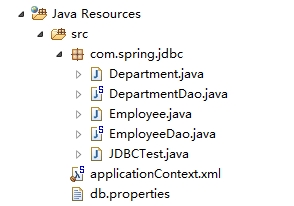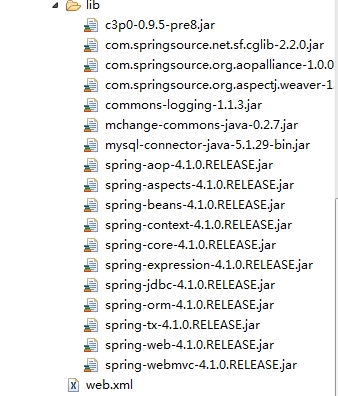Spring4学习笔记-JDBC
引入的jar包与基于注解的方式引入的jar包相同
实体类
Employee.java 对应数据库中的employee表
public class Employee {
private Integer id;
private String last_name;
private String email;
private Department department;
//...省略get、set方法
} Department.java 对应数据库中的department表
public class Department {
private Integer id;
private String name;
//.....省略get、set方法
}EmployeeDao.java
/**
* 在实际开发中这么使用
* @author umgsai
*/
@Repository
public class EmployeeDao {
@Autowired
private JdbcTemplate jdbcTemplate;
public Employee get(Integer id) {
String sql = "select id, last_name, email from employee where id = ?";
RowMapper<Employee> rowMapper = new BeanPropertyRowMapper<>(Employee.class);
Employee employee = jdbcTemplate.queryForObject(sql, rowMapper, id);
return employee;
}
}DepartmentDao.java
/**
* 不推荐使用JdbcDaoSupport,而推荐使用JdbcTemplate作为Dao类的成员变量
* @author umgsai
*/
@Repository
public class DepartmentDao extends JdbcDaoSupport{
//注入dataSource
@Autowired
public void setDataSource2(DataSource dataSource) {
setDataSource(dataSource);
}
public Department get(Integer id) {
Department department = null;
String sql = "select id, name from department where id = ?";
RowMapper<Department> rowMapper = new BeanPropertyRowMapper<>(Department.class);
department = (Department) getJdbcTemplate().queryForObject(sql, rowMapper, id);
return department;
}
}applicationContext.xml
<?xml version="1.0" encoding="UTF-8"?>
<beans xmlns="http://www.springframework.org/schema/beans"
xmlns:xsi="http://www.w3.org/2001/XMLSchema-instance" xmlns:context="http://www.springframework.org/schema/context"
xsi:schemaLocation="http://www.springframework.org/schema/beans http://www.springframework.org/schema/beans/spring-beans.xsd
http://www.springframework.org/schema/context http://www.springframework.org/schema/context/spring-context-4.1.xsd">
<context:component-scan base-package="com.spring.jdbc"></context:component-scan>
<!-- 导入资源文件 -->
<context:property-placeholder location="classpath:db.properties" />
<!-- 配置C3P0数据源 -->
<bean id="dataSource" class="com.mchange.v2.c3p0.ComboPooledDataSource">
<property name="user" value="${jdbc.user}"></property>
<property name="password" value="${jdbc.password}"></property>
<property name="driverClass" value="${jdbc.driverClass}"></property>
<property name="jdbcUrl" value="${jdbc.jdbcUrl}"></property>
<property name="initialPoolSize" value="${jdbc.initialPoolSize}"></property>
<property name="maxPoolSize" value="${jdbc.maxPoolSize}"></property>
</bean>
<!-- 配置Spring的JdbcTemplate -->
<bean id="jdbcTemplate" class="org.springframework.jdbc.core.JdbcTemplate">
<property name="dataSource" ref="dataSource"></property>
</bean>
</beans>db.properties
jdbc.user=root jdbc.password=123456 jdbc.driverClass=com.mysql.jdbc.Driver jdbc.jdbcUrl=jdbc:mysql:///test jdbc.initialPoolSize=5 jdbc.maxPoolSize=10
JDBCTest.java
public class JDBCTest {
private ApplicationContext applicationContext = null;
private JdbcTemplate jdbcTemplate;
private EmployeeDao employeeDao;
private DepartmentDao departmentDao;
{
applicationContext = new ClassPathXmlApplicationContext("applicationContext.xml");
jdbcTemplate = (JdbcTemplate) applicationContext.getBean("jdbcTemplate");
employeeDao = applicationContext.getBean(EmployeeDao.class);
departmentDao = applicationContext.getBean(DepartmentDao.class);
}
@Test
public void testDepartmentDao() {
System.out.println(departmentDao.get(2));
}
@Test
public void testEmployeeDao() {
System.out.println(employeeDao.get(9));
}
/**
* 获取单个列的值或做统计查询
*/
@Test
public void testQueryForObject2() {
String sql = "select count(id) from employee";
long count = jdbcTemplate.queryForObject(sql, Long.class);
System.out.println(count);
}
/**
* 查询实体集合
*/
@Test
public void testQueryForList() {
String sql = "select id, last_name, email, department_id as \"department.id\" from employee where id >0";
RowMapper<Employee> rowMapper = new BeanPropertyRowMapper<>(Employee.class);
List<Employee>employees = jdbcTemplate.query(sql, rowMapper);
System.out.println(employees);
}
/**
* 从数据库获取一条记录,实际得到对应的一个对象。
* 不是ORM框架,不支持级联属性。
*/
@Test
public void testQueryForObject() {
String sql = "select id, last_name, email, department_id as \"department.id\" from employee where id = ?";
RowMapper<Employee> rowMapper = new BeanPropertyRowMapper<>(Employee.class);
Employee employee = jdbcTemplate.queryForObject(sql, rowMapper, 9);
System.out.println(employee);
}
/**
* 执行批量操作(update、insert、delete)
*/
@Test
public void testBatch() {
String sql = "insert into employee (last_name, email,department_id) values (?, ?, ?)";
List<Object[]>batchArgs = new ArrayList<Object[]>();
batchArgs.add(new Object[]{"dd", "[email protected]", 2});
batchArgs.add(new Object[]{"ff", "[email protected]", 2});
batchArgs.add(new Object[]{"rr", "[email protected]", 3});
batchArgs.add(new Object[]{"tt", "[email protected]", 4});
batchArgs.add(new Object[]{"yy", "[email protected]", 1});
batchArgs.add(new Object[]{"uu", "[email protected]", 1});
jdbcTemplate.batchUpdate(sql, batchArgs);
}
@Test
public void testUpdate() {
String sql = "update employee set email = ? where id = ?";
jdbcTemplate.update(sql, "[email protected]", 1);
}
@Test
public void testDataSource() {
DataSource dataSource = applicationContext.getBean(DataSource.class);
try {
System.out.println(dataSource.getConnection());
} catch (SQLException e) {
// TODO Auto-generated catch block
e.printStackTrace();
}
}
}本文出自 “阿凡达” 博客,请务必保留此出处http://shamrock.blog.51cto.com/2079212/1557816
郑重声明:本站内容如果来自互联网及其他传播媒体,其版权均属原媒体及文章作者所有。转载目的在于传递更多信息及用于网络分享,并不代表本站赞同其观点和对其真实性负责,也不构成任何其他建议。





































